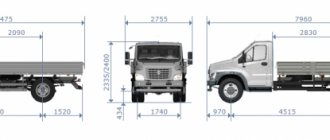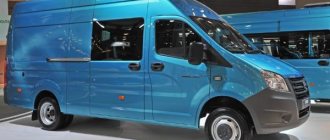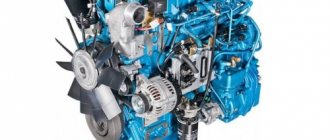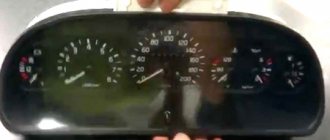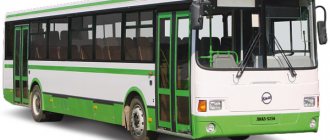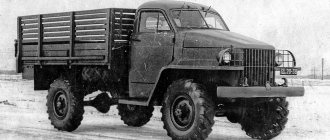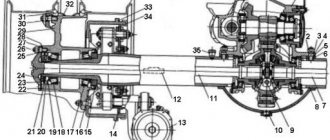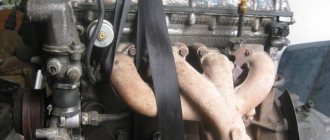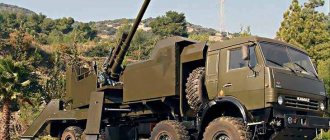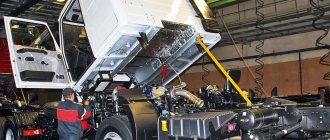Model history
Throughout the first decade of the 2000s, every year it became more and more obvious that the huge commercial success of Gazelle cars in the Russian and CIS markets would not last forever. Gazelle has plenty of competitors in the field of light-duty business vehicles, and they all have something to interest a potential buyer.
The price factor no longer always became the most important and determining factor when purchasing, especially since the car lending system has developed extraordinary over the years, and loans began to be issued to almost “everyone.” And buyers have become more picky, able to compare and contrast, and are ready to overpay for comfort and reliability in operation, and increased profitability. Therefore, “Gazelle” gradually lost its position, being forced out of the market by more expensive, but also more modern imported “classmates”.
A “response move” in this situation could only be the launch of mass production of a new car, corresponding in quality to modern “classmates” (such as Mercedes Sprinter, Peugeot Boxer, Volkswagen Crafter, Ford Transit, Fiat Ducato ", etc.) But at the same time having a more attractive price!
Meanwhile, the new family may not have reached the assembly line, which has happened more than once with other developments by domestic designers. The following course of action was considered: not to go into the business of creating your own model, which requires enormous capital investments and hassle, but simply assemble the previous generation Mercedes Sprinter at GAZ facilities.
However, even with the highest level of localization, the German light-duty vehicle turned out to be by no means cheap, and in no way falls into the rank of a “budget” car. Domestic consumers, for the most part, should be given a simple frame car (the Sprinter has a monocoque body), which can be overloaded regularly and without serious consequences, and all sorts of minor repairs can be carried out, as they say, “on the knee”, without taking a long break from workflow.
To prepare for the release of the new model, the Gorky Automobile Plant carried out a large-scale modernization of production. The total investment in the Gazelle Next project amounted to almost nine billion rubles.
To produce the new model of the all-metal GAZelle Next van, new automated welding and stamping complexes were created at the Gorky Automobile Plant sites, the painting production and assembly line were modernized.
The automated stamping line is equipped with the latest multifunctional six-axis robots of the latest generation and presses with imported stamping equipment specially made for the project. The line produces large parts, including side panels, bases, sliding and swing doors.
The new welding line allows automatic production of bodies of various modifications. Modern Fanuc robots with a lifting capacity of up to 700 kg are installed in the welding areas of the sidewalls, base, body and door assembly-welding. Each robot, independently changing equipment, is capable of performing operations such as transporting parts, welding, flanging, and applying adhesives and sealants. The welding line also includes new overhead push conveyor routes and automated components supply systems.
Following the basic flatbed version and the universal chassis, other “Gazelle Next” followed: in March 2014, serial production of a truck with a seven-seat double cabin and a bus with a frame-panel body in urban and intercity versions began; In April 2016, sales of all-metal Gazelle Next vans started.
The substantial investments began to pay off: new cars are selling well on the domestic market: more than fifteen thousand buyers choose them every year. The Gazelle Next assembly production for the needs of the local market was also organized in Turkey.
Predecessor and main features of the YaMZ-534 engine
Externally, GAZelle Next has radically changed in comparison with the previous Gazelle. In the front part, attention is drawn to the large radiator grille and the large, voluminous bumper with fog lights integrated into it. The plastic body kit is made of four different segments. Due to this, in case of minor accidents, the metal front part of the car will not be damaged, and it will not have to be replaced.
The headlights are the same; almond-shaped, or teardrop-shaped. Only they are located much higher, at the junction of the plastic wings, the sloping hood and the side of the bumper. By the way, the long-standing problem of wing corrosion has been solved radically and forever: now they are not metal, but plastic.
The side rear view mirrors have increased by about a third. They became divided into 2 parts, one of them is panoramic. The mirror mounts have become much stronger and more reliable. In addition, the base already has electrically heated mirrors. The more expensive configuration also includes electrical adjustment. Under the cab on both sides there are hidden drawers for tools and the factory hood seal. Windshield washer nozzles are now located on the windshield wipers.
Raising the hood, one cannot help but notice that the engine compartment has become more spacious, thanks to which GAZ specialists were able to space out the intercooler and the main radiator of the cooling system. This, together with the fact that the purge area of the radiator itself has almost doubled, significantly reduced the thermal load on the engine.
It is impossible not to note the abundance of foreign-made parts and components: ZF steering; front optics "Magneti Marelli"; anti-lock braking system manufactured by Bosch; "Mando" braking system; SKF gearbox bearings; Sachs clutch; wheel bearings "Schaeffler";
In motion, the “next Gazelle” has become quieter compared to the usual one, the smoothness of the ride on a broken road has noticeably increased, and the problem of suspension rigidity and noise in the car when driving in an unloaded state has been eliminated. Driving performance was improved by revising the aerodynamics and refining the cabin supports, improving the design of the rear suspension and springs (something that Gazelle owners have long pointed out).
The main innovation, which takes the Gazelle Next to a completely different level of comfort, is the new independent front suspension on double wishbones. Even the basic equipment is equipped with 9th generation four-channel ABS.
According to the manufacturer, another pressing problem of the Gazelles has been solved - the high susceptibility of the body to corrosion. It is claimed that the body of the Gazelle Next is of high quality. Only galvanized metal is used to make the running boards, hood, wheel arches, doors and side panels.
Especially for the production of the new family, an advanced hydroelastic stamping press “Quintus FlexForm” was launched in Nizhny Novgorod, which allows the use of a one-sided matrix when creating liquid pressure at a level of 100 MPa. Equipment is used to create body elements for Gazelle Next, making them of higher quality.
The YaMZ-534 Euro-4 engine is an in-line four-stroke diesel engine, with compression ignition, direct injection, liquid cooling, turbocharging and charge air cooling in an air-to-air heat exchanger. Each of the engine cylinders has four valves each.
Although the Yaroslavl Motor Company’s lineup already included the 4-cylinder YaMZ-204 engine, which was discontinued more than twenty years ago, this, as they say, was “a completely different story.” Because that engine was a heavy diesel engine. And the design did not even provide for its equipping with a turbocharging system. Therefore, the four-cylinder YaMZ-204 can be called the predecessor of the 534, but only with a stretch.
After all, the YaMZ-534 is a medium-sized in-line diesel engine, developed, as they say, “from scratch” by the design bureau of the Yaroslavl Motor Plant, together with the Austrian engineering bureau “AVLListGmbh”.
Distinctive features of YaMZ-534 are compliance with modern environmental standards Euro-4; the presence of an electronic control unit (ECU) and the use of a modern direct injection system using the CommonRail battery fuel system.
Achieving a high level of environmental standards was made possible largely thanks to the use of the EGR exhaust gas recirculation system. One of the advantages of this solution is simplification, and therefore reduction in cost, of placing the engine on the car.
“YaMZ-534” is a fundamentally new design, using the most current and advanced solutions, the rights to which belong to the GAZ Group (in recent years, this holding has included the Yaroslavl Motor Plant).
Lawn Next truck with YaMZ 53441-2 engine (150 hp)
For the serial production of diesel engines of the 530 family, a completely new plant was built and launched as part of YaMZ - Avtodizel OJSC. This new enterprise is located on the current outskirts of the city, as the locals say - “beyond the Volga”, about a twenty-minute drive from the old plant.
This is the most modern production of diesel engines not only in Russia, but throughout Eastern Europe.
This modern industrial site has almost a 90% level of production automation, and all production equipment on it is from the world's leading manufacturers. In addition to the new 530 series diesel engines, German engines for Mercedes Sprinter minibuses are also assembled here.
Among the suppliers of individual components and components of the new Yaroslavl 4-cylinder engine are such venerable manufacturing companies with a long-term and impeccable reputation as Bosch, ZF, FederalMogul, BorgWarner, MannHummel, Behr, Knorr/ Bremse" and others.
The casting of the block and cylinder head is carried out in Germany, at the FritzWinter enterprise.
However, the new Yaroslavl four-cylinder diesel engines do not consist entirely of imported components and components, as it might seem. For example, CommonRail fuel equipment is Russian-made, from the Yaroslavl Diesel Equipment Plant.
The electronic control unit and, what is especially characteristic, the software for it, were developed by St. Petersburg, and the production of the ECU itself was mastered at the Stary Oskol Automotive Electrical Equipment Plant.
The production of electronically controlled fuel injectors, providing increased spray pressure and multi-phase injection (three portions), has been established at the Altai Precision Products Plant in the city of Barnaul.
Currently, the price list of the Yaroslavl Motor Plant includes nine modifications of the YaMZ-534, in a power range from 136 to 190 horsepower. The YaMZ-534/CNG gas engine, which was the fruit of cooperation with a Canadian manufacturing company, stands out in particular.
History of creation
The 530 series of Yaroslavl engines is represented by two models - in-line 4- and 6-cylinder diesel engines. The design and production of the first samples began back in 1995-2008. Already in 2009, a pilot batch was produced for testing. In parallel with this, construction of a plant was carried out in the Volga part of Yaroslavl, which was launched in 2011. The development of this series was carried out jointly with engineers from the Austrian engineering company AVL List. The engine has become a novelty not only for the domestic automobile industry, but also for Avtodiesel itself. The applied development methods made it possible to create a new engine meeting Euro-4 and Euro-5 environmental standards with a volume of 1 liter per cylinder.
Until 2022, cast iron cylinder blocks were imported, in particular, from the German plant Fritz Winter Eisengielierei, which is a supplier of castings for brands such as BMW, Mercedes-Benz and Volvo. Now the casting of YaMZ 534 is organized at GAZ OJSC, which previously supplied aluminum parts (flywheel housing, front cover, etc.).
2 in Kostroma and Federal Mogul in Naberezhnye Chelny are involved in the manufacture of piston groups. Until recently, crankshaft packages were supplied by the German company ThyssenKrupp AG, and processing was carried out at YaMZ itself. At the moment, metallurgists from KAMAZ are supplying crankshafts.
Such domestic manufacturers as YAZDA (components for high-pressure fuel injection pumps), Itelma (electronic filling), NPO Turbotekhnika (turbocompressors), ZMZ (liners, camshaft bushings) are also involved in production cooperation.
Import substitution of engine parts reached 80% in 2022 (2015 – 68%, 2016 – 76%).
Review of YaMZ-534 modifications and scope of their application
In terms of their capabilities, YaMZ-534 engines are very versatile. These motors effectively perform the functions of power units on a variety of equipment weighing up to 12 tons, together with cargo; or on road trains weighing up to 21 tons. It is allowed to use these engines on vehicles with a number of wheels from 4 to 6, with two or four driving wheels.
Initially, YaMZ-534 diesel engines, all their modifications and configurations, were intended for installation on MAZ, Ural (new model), GAZ and GAZonNext (gas fuel) trucks, as well as small and medium capacity buses of the PAZ brand.
The key differences between the individual modifications lie, first of all, in the settings of the ECU - an electronic fuel supply system optimized for specific tasks.
A more detailed overview of the specific application of modifications to these motors is as follows:
- “YAMZ-5340” is a basic modification used as a power unit for trucks, dump trucks, chassis, tractors with the wheel arrangement “4x2”, “4x4”, “6x2”, “6x4”, with a gross weight of up to 12 tons, road trains on their basis up to 21 tons - Minsk Automobile. There are also three additional modifications: with preparation for installation of an air conditioning compressor (“YaMZ-5340/01”), with a fan (“YaMZ-5340/02”), with a fan prepared for installation of an air conditioner compressor (“YaMZ-5340/03”) .
- "YAMZ-53402" - designed for trucks "Ural-432065" and other vehicles of the "Ural" brand, including all-terrain vehicles with a 4x4 wheel arrangement, with a total weight of up to 13 tons, for road trains based on them up to 24 -x tons weighing. A separate special modification “YaMZ-53402-10” is used as part of the tracked snow and swamp-going vehicle “ZZGT”.
Truck "Ural-432065" with engine "YAMZ-53402" (190 hp)
- “YAMZ-5341” - this engine is used as a power unit for the following MAZ-branded equipment: medium-tonnage vehicles, on a vehicle chassis with a 4x2 wheel arrangement and a total weight of up to 6 tons, for road trains based on them up to 10 tons, and for buses.
- “YAMZ-5341/10” - this motor is used as a power unit for buses of the “PAZ-320412” family, with a gross weight of up to 11 tons. There is also a special modification “YaMZ-5341/11” for installing an air conditioning compressor.
- "YaMZ-5342" - used as a power unit for buses of the "PAZ-320402", "PAZ-4234", "PAZ-3237" models, with a gross weight of up to 11 tons.
- YaMZ-5344 is a modification for PAZ-32053 buses.
- YaMZ-5344-10 is a diesel engine option specifically for medium-tonnage trucks of the GAZ-3308 (Sadko) and GAZ-3309 family.
- YaMZ-53442 is a special modification designed for medium-tonnage off-road trucks of the GAZ-3308 family and their chassis.
- YaMZ-534/CNG is the newest and most promising modification, launched into production only at the end of 2015. Powered by gas. At first, it will be equipped with new versions of GAZ trucks, and in the near future – with a wide range of all kinds of equipment for various purposes.
In addition, since May 2014, the plant launched serial production of an accelerated modification - "YAMZ-53472-10", with a power of 215 horsepower at 2600 rpm, specially designed for the new army armored vehicles "GAZ-233036" (it aka "SMP-2 "Tiger").
The main options for the Gazelle Next car are a truck, an onboard cargo platform; universal chassis for installing settings and all kinds of special equipment; bus in city and intercity interior design; all metal van. The vehicle is available with a standard or extended wheelbase.
1. The flatbed version differs from the regular Gazelle by a reinforced frame and the use of stainless materials. The architecture of the platform has also been improved. If previously only three euro pallets could be placed in the body, now their number has increased to five, which immediately increases transportation productivity by forty percent! The load capacity of the frame chassis, however, has not changed, but voluminous loads, according to tradition, prevail over particularly heavy ones. Yes, and periodic overload of the Gazelle Next, like the previous Gazelle, will not frighten you. Modifications of the onboard Gazelle Next:
- With Cummins diesel: A21R22-30 – standard base; 3-seater cabin, A21R32-30 – extended wheelbase; 3-seater cabin, A22R22-30 – standard base; 7-seater cabin, A22R32-30 – extended wheelbase; 7-seater cabin.
- With UMZ gasoline engine: A21R23-20 – standard base; 3-seater cabin, A21R33-10 – extended wheelbase; 3-seater cabin, A22R23-10 – standard base; 7-seater cabin, NEXT A22R33-20 – extended wheelbase; 7-seater cabin.
- With UMZ gas engine: A21R25-20 – standard base; 3-seater cabin, A21R35-10 – extended wheelbase; 3-seater cabin, A22R35-20 – extended wheelbase; 7-seater cabin.
manufactured goods or isothermal van; europlatform; bread van; mobile auto shop; tow truck with broken platform; auto hydraulic lift; dump truck with three-way unloading; a vehicle with a crane-manipulator; milk tanker; ambulance; a vehicle for transporting people with disabilities; police duty vehicle; fire engine; "House on wheels".
Bread van on the Gazelle Next chassis.
3. The Gazelle Next passenger minibus is designed as a city minibus or as a commuter bus. Plus, this new product isn't just built around an all-metal van. Frame-panel technology was also used - using durable steel pipes, galvanized metal sidewalls and fiberglass panels.
Modifications of minibuses "Gazelle Next":
- Based on an all-metal van, 16 seats: A65R33-60 – with UMZ gasoline engine; A65R32-40 – with Cummins diesel engine; A65R35-60 – with UMZ gas engine;
- With frame-panel body, Cityline, 18-19 seats: A64R42-10 – city; A63R42-10 – commuter; A60R42-1010-56-721-70 – tourist (with Cummins diesel engine); A64R45-50 – urban; A63R45-50 – suburban (with UMZ gas engine).
Modifications of "Gazelle Next" in the "all-metal van" version:
- With UMZ gasoline engine: A31R23-20 – three-seater cabin, standard wheelbase; A32R23-20 – seven-seat cabin, standard wheelbase; A31R33-20 – three-seat cabin, extended wheelbase; A32R33-20 – seven-seat cabin, extended wheelbase.
- With Cummins diesel: A31R22-40 – three-seater cab, standard wheelbase; A32R22-40 – seven-seat cabin, standard wheelbase; A31R32-40 – three-seater cabin, extended wheelbase; A32R32-40 – seven-seat cabin, extended wheelbase.
fog lights; modern radio with USB connector and steering wheel controls; electric side mirrors; heated driver's seat. By paying extra, the buyer can get the top-end K2 package, which differs from K1 in the presence of a pre-heater, a heater and a battery with increased energy capacity.
Unit design
YaMZ-5344 is made of cast iron, the crankshaft is steel. The cylinders form a monolithic block with a common head with an intake air manifold. The design of the main subsystems is as follows:
- The ShPG consists of a one-piece piston, 3 piston rings, a steel pin, an I-section connecting rod, liners and an injector. The nozzle is located on the lower head of the connecting rod.
- Cooling. In the “front” part there are cooling units that operate from a belt drive. The cooling system is liquid; a water pump, a centrifugal pump and an axial fan with a clutch are mounted in the service module.
- Fuel filtration is carried out by two fuel filters (coarse and fine) produced by MANN+HUMMEL.
- The gas distribution device is overhead valve, the camshaft is located at the bottom.
- Lubrication is carried out by sucking oil from the crankcase with an oil pump and feeding it into the system through a liquid-oil heat exchanger and filter. The pump can only be accessed by first removing the flywheel housing.
- Fuel injection is coordinated by the ECU. The nozzle is a closed type. Includes a sprayer, hydraulically controlled needle lift, and an electromagnetic fuel supply valve.
The unit is equipped with a turbocharger that uses exhaust force to produce boost.
Engine repair manual
YaMZ-5344 is a “smart” unit, so it can diagnose a malfunction itself, indicating a breakdown by lighting up the diagnostic lamp. To determine what exactly failed, you need to hold down the diagnostic key for 5 seconds, after which the lamp will “signal” the code in the form of a certain series of flashes. All meanings of flash codes, as well as a detailed “Repair Manual” are given in the diagnostic instructions included in the kit. Repair and diagnostic activities include:
- replacement of filter elements (once a year as planned or in case of premature wear);
- tensioning the generator drive belts (change after every 8 thousand hours of operation) and cooling system units (change after every 4 thousand hours);
- adjustment of valves;
- replacing the cooling fluid (basin at three years) and oil.
In case of serious damage, you should contact the dealer. The spare parts catalog is also available on the official website of the manufacturer.
Reviews of YaMZ-5344 are not so common. Perhaps few people have yet been able to appreciate its potential. Or the price “bites”. Among the little things that exist, they primarily note the absence of strong noise and vibrations in operation, relatively small dimensions, low fuel consumption and affordable maintenance. However, unlike its predecessors, the 5344th model is very picky and requires the use of only the prescribed grades of oil and type of fuel.
The YaMZ-534 engine is a new family of L-shaped 4-cylinder diesel engines produced by the Yaroslavl Motor Plant. The YaMZ-534 series was developed from scratch. This engine belongs to medium in-line diesel engines and is used as a power unit for trucks, dump trucks, chassis, tractors with a wheel arrangement of 4x2, 4x4, 6x2, 6x4 and a total weight of up to 12 tons, as well as road trains up to 21 tons.
The YaMZ 534 engine is a four-stroke in-line diesel engine with compression ignition, direct injection, liquid cooling and turbocharging. Distinctive features of YaMZ 534 are:
- compliance with modern environmental standards "Euro-4";
- presence of an electronic control unit;
- the use of a modern direct injection system using a Common Rail battery fuel system.
Specifications
| Engine type | diesel |
| Start of release | 2012 |
| Power, kW (hp) at 2300 rpm | YaMZ-5340: 140 (190) YaMZ-5341: 125 (170) YaMZ-5342: 110 (150) YaMZ-5344: 100 (136) |
| Maximum torque, Nm (kgf.m) | YaMZ-5340: 710 (72.5) at 1200-1600 rpm YaMZ-5341: 670 (68) at 1200-1600 rpm YaMZ-5342: 590 (60) at 1300-1600 rpm YaMZ-5344 : 421 (43) at 1200-2100 rpm |
| Volume | 4430 cc |
| Number of cylinders | 4 |
| Number of valves | 16 |
| Cylinder operating order | 1 – 3 – 4 – 2 |
| Compression | 17,5:1 |
| Cylinder diameter, mm | 105 |
| Piston stroke, mm | 128 |
| Engine shape | L4 inline |
| Type of fuel | diesel fuel |
| Supply of combustible mixture | direct injection |
| Exhaust gas standard | Euro 4 |
| Cooling | liquid, air-to-air |
Technical characteristics of the YaMZ-534 engine
All of these modifications of the new four-cylinder diesel engines are maximally unified among themselves and cover the power range from 136 to 215 horsepower. At the same time, the minimum specific fuel consumption is, according to the manufacturer, 145 g/l.h.h. And this number is a very good indicator by modern standards, meeting the most current fuel efficiency standards.
Thanks to the presence of the innovative CommonRail direct injection battery fuel system, equipped with an ECU - an electronic control unit, precise fuel supply calibration parameters are achieved for a number of diverse operating modes. This makes it possible to simultaneously ensure both a reduction in fuel consumption and an increase in engine efficiency.
Some technical indicators in specific terms:
- Working volume – 4430 cubic centimeters;
- Power - from 136 to 215 hp, depending on modification, at 2300-2600 rpm;
- Number and arrangement of cylinders – 4, “L”;
- Cylinder diameter/piston stroke, in millimeters – 105/128;
- Compression ratio – 17.5;
- Maximum torque, Nm (kg/s.m) – 735 (75);
- Rotation speed at maximum torque – 1300-1600 rpm;
- The height of the crankshaft axis is 300 mm;
- Environmental indicators – Euro-4 (EGR POC);
- Overall dimensions (Length/Width/Height), in millimeters: 972/712/836;
- Engine weight, unfuelled: 480 kg;
- Cylinder operating order: 1 – 3 – 4 – 2;
- Power system: CR direct injection.
To achieve the Euro-4 environmental level, an EGR (exhaust gas recirculation) system and a catalytic converter with a replaceable filter are used.
We can hope that the new YaMZ-534 engine will become another example of a reliable, unpretentious and durable solution for a power unit. After all, the Yaroslavl Motor Plant has been the largest player in the industry for more than half a century and has not betrayed itself. In the sense that its classic products - engines of the YaMZ-236, YaMZ-238 family have an impeccable reputation as engines that are extremely durable and reliable, a sort of “perpetual motion machine” among diesel engines.
Engine "YaMZ 534" in the assembly shop of the plant
The new power unit, YaMZ-534, according to the manufacturer, has a predicted service life before major overhaul from 700 thousand to 1 million km; with the need for maintenance every 30 thousand km. (or 1000 hours of work).
The rate of oil consumption due to waste is no more than 0.1% of diesel fuel consumption, which corresponds to the most advanced examples of such equipment from the world's leading manufacturers.
The manufacturer's warranty for power units of this series is two years, or 100 thousand kilometers.
YaMZ-534 motors are in high demand on the market: their production volumes amount to tens of thousands of units per year. In this case, the first maintenance is scheduled after 15 thousand km (or 500 hours), the second and subsequent engine maintenance – after 30 thousand km (or 1000 hours)
Description of the YaMZ-5344 engine
The 5344th model of the YaMZ engine was created for installation on the PAZ-32053 (including the entire model range of this family). Has two modifications:
- “5344-10” is intended for “mid-range” GAZ-3308/9;
- “53442” - for GAZ-3308 models marked with increased cross-country ability.
Available in two configurations for mounting an air conditioning compressor (for the above-mentioned “families” GAZ and PAZ).
The basis for the design of the YaMZ-5344 is the 5340th model; the difference lies only in the regulation of the fuel “supply”, since the settings of the electrical control unit differ. Thanks to the innovative exhaust recirculation system, the engine is brought into compliance with Euro-4 eco-standards. The average working life of the unit is 700 thousand kilometers. The cost on the official website of the manufacturing plant is 560 thousand rubles.
Manual
Errors in operating the engine will significantly shorten its service life. Therefore, it is worth paying attention to some features of its operation:
- after warming up to 80-100 C, long-term operation at minimum idle speed is prohibited, as is full load of the unit without warming up;
- the coolant should not heat up above 80-100 C (it is permissible to exceed the temperature by 5 C for no more than 10 minutes);
- To ensure that the turbocharging system does not fail, before turning off the engine, it is necessary to run for 2-3 minutes at minimum idle speed;
- after a long period of inactivity or changing fuel injection pump filters, the fuel supply system must be pumped with fuel.
- You cannot use coolers, lubricants, filters that are not prescribed by YaMZ-5344.
Applicable:
- oil filter W11102 ;
- base coolant – GlycoShell (or concentrate);
- base engine oil – Shell Rimula R4L (SAE 15W-40, API CJ-4, CI-4, CH-4, CG-4, CF-4, CF);
- base diesel fuel – type II or III according to GOST R52368-2005 with a sulfur content of no more than 50 mg/kg.
It is acceptable to use analogues, the list of which is shown in the “Operation Manual” included with the unit.
Since the engine is equipped with the “brains” of the ECU, in the event of overheating, excessive speed, loss of oil pressure and other emergency situations, it stops working automatically.
When running in a new unit, avoid full load or driving at high speeds.
Gazelle Next parameters, standard base
- length – 5.630 m;
- width – 2.068 m;
- height – 2.137 m;
- wheelbase - 3.145 m;
- turning radius – 5.6 m;
- ground clearance - 170 mm;
- front track - 1,750 m;
- rear track – 1,560 m;
- curb weight – 2,060 t;
- load capacity – 1,440 t;
- total weight – 3.5 t;
- maximum speed – 134 km/h.
- length – 6.709 m;
- width – 2.068 m;
- height – 2.137 m;
- wheelbase - 3.745 m;
- turning radius – 6.5 m;
- ground clearance - 170 mm;
- front track - 1,750 m;
- rear track – 1,560 m;
- curb weight – 2,230 t;
- load capacity – 1,270 t;
- total weight – 3.5 t;
- maximum speed – 132 km/h.
The loading height is 95 centimeters. internal dimensions of the cargo platform: length – 3090 mm (standard); 4168 mm (extended version) – with a 3-seater cabin; length – 2339 mm (standard); 3090 (long version). Overhang angle (with load): front – 22 degrees; rear - 16 degrees. The maximum volume overcome is 26 degrees.
Dimensions of the minibus in millimeters (length x width x height): 6080x2530x2720. Wheelbase - 3745 mm. Gross weight - 4252-4292 kg.
Operating experience and reviews from YaMZ-534 owners
The owners of Gazelle Next note that this is truly a completely new, modern, comfortable and productive car. It is cheaper than imported analogues and is less expensive to maintain. The basic package is rich in options. Fuel consumption, although slightly higher than stated by the manufacturer, is generally pleasing.
It starts well in the cold, down to minus 20 degrees. In hot weather, you can often see regular Gazelles with the hood slightly open, with a plastic bottle inserted into the crack. On the Gazelle Next, the possibility of overheating was eliminated by installing a much larger aluminum radiator. The owners could not help but note the new cargo platform of the GAZelle Next.
One of the minuses is the archaic gear shift knob, which sticks out lonely from the floor in the middle of a modern and comfortable interior. “Where is the joystick on the podium{q},” spoiled consumers ask. People also grumble about the unassuming “oak” plastic of the panels, the shapes of which are cast in places of poor quality, with burrs. Problems often arise with wiring and rear lighting devices: the contacts either come off on their own or close for no apparent reason.
But in general, all owners of GAZelle Next, especially those who switched from regular Gazelle, unanimously declare that the cars of the Gorky Automobile Plant have actually made a sharp leap forward, and not only in design and comfort, but also in quality of performance and assemblies. The cost, although it cannot be called cheap, is still more attractive than similar “Europeans” - for quite reasonable money you can get a reliable, practical and comfortable car. Where it will be pleasant to work and earn money.
Experience of owners of cars with YaMZ-534 engines, produced in 2011-2013 and already, so to speak, “smelling gunpowder”, i.e. have proven themselves under conditions of intensive use, indicating that the motor is good. More specifically: reliable; when necessary - high-torque, when necessary - playful and resourceful; works quietly; and, what is especially important in our time, economical (about 15-17 liters).
Each buyer of diesel equipment of this type has two options: YaMZ-534 or Chinese-made Cummins.
The Yaroslavl motor, judging by experience and reviews, is much better: more unpretentious, trouble-free, and, although not particularly cheap; Still, in terms of the price of spare parts and the engine itself, it will be preferable. And “YaMZ-534” cannot boast of an inexpensive price quite naturally: after all, a considerable part of the components and assemblies on it are from European manufacturers.
However, “jingoism” in the field of new technical developments is inappropriate in our modern era. And using technologies and ready-made units from world industry leaders is, perhaps, the right decision. Since using them turns out, as they say, “a completely different song.”
Diagnostics of YaMZ-5340, YaMZ-536 engines
Diagnostics of YaMZ-5340, YaMZ-536 engines
An increase in the number of electronic devices on a vehicle, the use of software to control the vehicle and an electrically controlled fuel supply system place high demands on the system for diagnosing and monitoring the operating mode (on-board diagnostics), as well as on diagnostics at service stations (service stations). The basis of diagnostics at a service station is reading and troubleshooting, combining various possibilities for their implementation using on-board and external monitoring devices. Due to stricter emission regulations and monitoring requirements, the On-Board Diagnostic System has been recognized as an emission control aid and has been standardized independently of the manufacturer. This additional system is called an on-board diagnostic system or OBD (On Board Diagnostic System).
ECM SELF-MONITORING DURING VEHICLE OPERATION (ON-BOARD DIAGNOSTICS SYSTEM).
SELF-DIAGNOSTICS OF ECM.
The diagnostic system integrated into the control unit is one of the main devices of the ECM. In addition to self-monitoring of the control unit, input and output signals are monitored, as well as data transfer between control units.
The on-board diagnostic system of the ECM should be understood as the ability of the ECU to perform constant self-monitoring using software, that is, to identify, store and process errors. The on-board diagnostic system operates without auxiliary devices.
By means of control algorithms, input and output signals, as well as the entire system as a whole with all its functions, are checked for the presence of malfunctions and errors during operation. Errors determined in this way are stored in the memory of the control unit. When diagnosing a vehicle at a service station, the stored fault information is read via a serial interface and helps to quickly recognize the fault and make repairs.
CONTROL OF INPUT SIGNALS.
Sensors, electrical connectors and connecting lines (signal paths) leading to the control unit are controlled by digital input signals. Using this monitoring, you can detect sensor malfunctions, short circuits in battery power supply circuits (UBatt voltage), short circuits to ground, as well as open circuits. The following methods are used for this:
- control of sensor supply voltage;
- checking the measured values for acceptable values (for example, the coolant temperature should be between minus 40°C and plus 150°C , voltage
- 0.5 ... 4.5 V);
- if additional information is available, check the reliability of the recorded values (for example, comparing the rotation speed of the crankshaft and camshaft).
- redundancy of critical components (for example, accelerator pedal position sensors are duplicated). This allows direct comparison of sensor signals directly with each other.
CONTROL OF OUTPUT SIGNALS.
Control of actuators and devices controlled by the control unit is carried out through the output circuits of the control unit. During the monitoring process, not only faults of the devices themselves are identified, but also short circuits and breaks in connecting lines are determined. The following methods are used for this:
- hardware monitoring of the output signal circuits of the final stages of the control unit, which are checked for short circuits or wire breaks;
- checking the system actions of actuators for reliability. The state of the system actuators (for example, the EGR system valve) is monitored indirectly (for example, by system reactions) and partly using position sensors (for example, an EGR damper position sensor).
CONTROL OF THE INTERNAL FUNCTIONS OF THE CONTROL UNIT.
To ensure correct operation of the ECU at any time, it contains hardware and software control functions.
During the monitoring process, the condition of all components of the control unit is checked (microprocessor, erasable programmable read-only memory - SPP3U, random access memory - O3U).
Many checks are carried out immediately after turning the key installed in the instrument and starter switch to position “I” (instruments are on), and then are performed at regular intervals during operation so that failure of any structural element is quickly detected. Processes that require a large amount of calculations (for example, checking the EPROM memory module), or for other reasons cannot be performed during vehicle operation, are carried out after the engine is turned off. This avoids affecting other functions. In the Common Rail battery system for diesel engines, during acceleration or coasting, for example, the injector disconnect circuits are checked.
CONTROL OF COMMUNICATION BETWEEN ELECTRONIC CONTROL UNITS.
Communication between various vehicle electronic control units is usually carried out via a CAN bus, which ensures high reliability of information transfer. Since most messages are transmitted on the CAN bus at regular intervals, the ECU detects CAN bus failures by monitoring these intervals.
DEVICES FOR NOTIFYING ABOUT A MALFUNCTION.
When abnormalities in engine operation are detected, a diagnostic lamp lights up on the vehicle’s dashboard, indicating an “active” error. Diagnostic trouble codes are stored in read only memory (ROM) of the electronic control unit. Diagnostic codes can be read using the following devices:
- diagnostic lamp ( “DIAGNOSTICS” );
- diagnostic devices.
Note: “DIAGNOSTICS” lamp is installed on the instrument panel by the vehicle manufacturer.
Some vehicles may be equipped with electronic information display devices (diagnostic and monitoring devices) that allow you to directly read diagnostic codes. The procedure for viewing diagnostic codes using such devices is given in the corresponding Manual provided by the vehicle manufacturer.
Active codes reflect faults currently present in the system. These faults should be identified and corrected first. The diagnostic lamp can display all stored fault codes (active and inactive).
The codes registered in the ECU allow you to analyze:
- Periodically occurring malfunctions.
- Registered events.
- Engine operation history.
Once diagnostic codes are stored in the electronic memory, the corresponding faults may be eliminated. Therefore, such codes do not indicate the need for repairs and are inactive (the diagnostic lamp does not light up). Fault codes indicate that there is a problem with the system and roughly indicate the nature of the problem. Fault codes make troubleshooting easier.
After troubleshooting, the codes registered in the system memory should be deleted.
DIAGNOSTIC LAMP.
“DIAGNOSTICS” lamp is used to notify the driver of the occurrence of a malfunction (failure) by playing flashing codes. “DIAGNOSTICS” lamp installed on the vehicle dashboard is usually yellow. The designation “EDC” or “engine circuit” is applied to its surface.
When the key (terminal K15 is closed) installed in the instrument and starter lock is turned to position “ I ” (instruments are on) “DIAGNOSTICS” lamp turns on. At this point, the ECM is diagnosed. With a working system
The ECM diagnostic lamp should go out after the diagnostic period (after 1-2 s). If the “DIAGNOSTICS” does not go out, there are malfunctions in the system (active errors).
ATTENTION! IF THE DIAGNOSTIC LIGHT IS ON AND DOES NOT GO OUT, THEN THERE IS A MALFUNCTION IN THE ELECTRONIC SYSTEM THAT MUST BE REPAIRED
VIEWING DIAGNOSTIC BLINK CODES.
To read diagnostic flashing codes, use the “DIAGNOSTICS” or an electronic information display device (diagnostic and monitoring devices).
If the vehicle is equipped with a “DIAGNOSTICS” , then information about control system errors accumulated in the ECU memory can be obtained using a flashing light code ( blink code ) of the diagnostic lamp by pressing and holding the diagnostic key for more than two seconds (see the vehicle manual).
After releasing the key, the ECU sends a light code ( blink code) of the engine malfunction to the diagnostic lamp in the form of a series of flashes (see example of blink code 1-2-4 in the figure): first, the first digit of the light code flashes - hundreds, then after a pause - the second digit is tens, and at the end, after a pause, the third digit of the light code is units. To display the next fault code, you need to press the diagnostic key again. In this way, all faults stored in the electronic unit are displayed. After the last fault is output, the unit begins to repeat the first fault again.
Example of blink code 1-2-4 (low voltage on-board network).
To eliminate detected faults, you must contact the service center.
OBD SYSTEM FAILURE INDICATOR LAMP.
The malfunction indicator lamp (MIL - Malfunction Indicator Lamp) informs the driver about a malfunction of a particular component that has caused the maximum permissible concentrations of toxic substances in the exhaust gas to be exceeded. In accordance with the requirements of UNECE Regulation No. 49-05, the MIL indicator must light up no later than at the end of the third driving cycle after detection of a malfunction.
After eliminating the malfunction (for example, after restoring a loose contact), the error is assigned the status of inactive, while the information on this error remains recorded in the ECU memory. The length of time an error is stored depends on its class. The MIL goes out after three driving cycles with no faults present.
REGISTRATION OF FAULT CODES.
The ECM provides the ability to record and store faults that occur in the electronic memory of the ECU.
DETECTION AND ELIMINATION OF ERRORS AND FAULTS DETECTION OF ERRORS AND FAULTS.
The signal from the sensor or control unit is considered defective if a malfunction occurs after a certain time. Until the defect is classified, the system will use the last recorded value. After the defect has been classified, the standby function is activated (for example, a fixed value of the engine temperature T = 90 ºС ), and then the transition to emergency operation begins.
For most errors, the recovered signal recognition function is available. To do this, it is necessary that the signal be determined to be serviceable for a certain time.
SAVING INFORMATION ABOUT FAULTS.
All faults are recorded in a non-volatile memory area of the control unit in the form of error codes. This error code also describes the fault (eg short circuit, open circuit, signal invalid, out of range) and the error status (eg permanent fault or single fault). Each fault code record is accompanied by a record of additional information (Freeze Frame) containing operating conditions and environmental parameters at the time of the malfunction (for example, engine speed and coolant temperature).
For many errors that affect the level of harmful exhaust emissions, error codes are established by law.
After recording the error, the diagnosis continues. If the error no longer occurs (single error), it is deleted from the error memory after certain conditions have been met.
FUNCTIONS IN EMERGENCY MODE (LIMP HOME).
When a malfunction occurs, in addition to using fixed values for certain parameters, the ECM can be placed in an emergency operating mode (for example, a mode that limits output power or engine speed). These actions serve to:
- ensuring traffic safety;
- preventing subsequent damage;
- reduction of harmful exhaust emissions.
READING AND ERROING ERRORS
There are two types of diagnostic codes: active and inactive.
Registered diagnostic codes (errors) can be retrieved from the ECU memory using both the “DIAGNOSTICS” or an electronic information display device (display) and diagnostic scanners such as KTS 5, 6 series from Bosch and ASKAN-10. After reading errors from the ECU memory using diagnostic scanners and correcting them at a service station, the errors must be deleted from memory.
ENGINE OPERATION WITH ACTIVE DIAGNOSTIC CODES.
If the diagnostic lamp lights up during engine operation, this means that the system has detected a situation that is outside the limits provided by the technical specifications. To view active diagnostic codes, use the “DIAGNOSTICS” or an electronic information display device (display), or diagnostic scanners such as KTS and ASKAN-10.
Note : Under certain conditions, engine power and vehicle speed may be limited. These measures are aimed at ensuring safety, preventing further damage, minimizing toxic emissions and allowing you to get to the service station under your own power. For example, if the engine overheats due to coolant, oil, fuel or air temperature, the ECU limits the engine power output, which continues until the fault is corrected.
The reasons for active diagnostic codes should be determined. Identified causes of malfunctions should be eliminated as soon as possible. If the cause of the active diagnostic code is resolved and there was only one active diagnostic code in the system, the diagnostic lamp turns off.
An active diagnostic code may result in limited engine performance and performance.
ENGINE OPERATION WITH PERIODICALLY APPEARING DIAGNOSTIC CODES.
If the diagnostic lamp begins to flash periodically during normal engine operation, this may indicate intermittent malfunctions. The occurrence of this malfunction is recorded in the ECU memory.
In most cases, if diagnostic codes occur intermittently, it is not necessary to stop the engine. However, the driver should determine which diagnostic codes are recorded in the memory and, using the appropriate information, identify the reason for their occurrence. The driver must record all identified factors that could cause the diagnostic lamp to come on; At the same time, pay attention to the following signs:
- Reduced power.
- Limiting engine speed.
- Increased smoke and the like.
This information may be helpful in finding and troubleshooting the cause of diagnostic codes. It can also be used when performing benchmarking in the future.
COMPUTER DIAGNOSTICS OF ENGINE.
Diagnosis of modern engines is typically performed using a computerized diagnostic tester. During diagnostics, the condition of various engine components and assemblies is assessed based on direct and indirect signs. This includes not only the analysis of errors stored in the ECU, but also the analysis of the parameter values produced by one or another sensor.
For ECM diagnostics, Avtodiesel OJSC has approved the following as diagnostic devices:
- system testers (scanners) BOSCH KTS 530/540/570 ( fifth series ) and KTS 6ХХ (sixth series) from BOSCH;
- diagnostic tester (scanner) ASKAN-10 , manufactured by LLC NPP ELKAR, Moscow.
the BOSCH KTS 530 diagnostic tester and ESI[tronic] software:
- The manual “Instructions for the user and safety regulations when working with Bosch diagnostic tools” (1 689 979 922).
- Operating instructions KTS 530_540_570.
- Instructions for using and setting up the ESI[tronic] program.
- Brochure “Product Description” for the corresponding KTS module.
For KTS 520 / 550 the brochure number is 1 689 979 857.
For KTS 530 / 540 / 570 brochure number 1 689 979 987.
For KTS 650 the brochure number is 1 689 979 856.
When diagnosing an engine using the ASKAN-10 , it is necessary to install the BOSCH EDC YaMZ diagnostic package. When working with the tester, you must be guided by the Passport and User Manual of the diagnostic tester ASCAN-10 , as well as the Instructions for working with the ASCAN Loader program.
PROCEDURE FOR COMPUTER DIAGNOSTICS.
Computer diagnostics must be carried out in the following order:
- Connect the diagnostic equipment using an adapter cable to the diagnostic block (OBD II connector, Figure 3) of the engine management system (see vehicle electrical diagram). In this case, the key of the instrument and starter switch must be in position “0” - the power is turned off. Otherwise, the diagnostic equipment may be damaged.
- Set the instrument and starter switch to position “ I ” - the instruments are turned on.
- Once communication has been established between the diagnostic equipment and the control unit, a corresponding message will appear on the tester screen. The control unit is recognized automatically and then the operator, carrying out certain actions in accordance with the instructions for working with diagnostic equipment, reads the actual parameter values, error memory and other specific data.
- Identification data of the control unit by model, version and software version must correspond to the documentation for the control units and the engine assembly.
- Record and save errors stored in the ECU memory. Failure to report errors may void the warranty.
- If a malfunction is detected in the control system, it must be eliminated.
- After eliminating the malfunction, it is necessary to clear all errors and re-diagnosis the engine control system for errors.
- At the end of the diagnostics, turn the key of the instrument and starter switch to position “ 0 ”. No earlier than 30 seconds , turn off the ground and turn off the diagnostic equipment.
FAULT CODES.
Fault codes for YaMZ-5340, YaMZ-536 engines with on-board diagnostic system
Fault codes for YaMZ-5340, YaMZ-536 engines without an on-board diagnostic system
Blink code is a code that allows you to identify a failure using a diagnostic lamp.
SPN code is used for many purposes; some of them intended for diagnostic purposes are as follows:
- identification of the engine system, ECU or unit in which the failure occurred;
- identification of subsystems and/or nodes with deviations in operation;
- identification of particular phenomena or conditions to be reported;
- notification of non-standard forms of component failure.
The SPN is determined by the SAE Standards Body.
FMI code according to SAE J 1939 standard, fault type indicator. Identifies the type of fault detected in the subsystem identified by the SPN.
To eliminate detected faults, you must contact the service center.
TROUBLESHOOTING.
The troubleshooting procedure includes: analysis of error codes recorded in the ECU memory while the vehicle is moving; diagnostic modules built into the diagnostic tester and additional test and measurement equipment of the service station.
All service station diagnostic modules can only be used when the diagnostic tester is connected and the vehicle is, as a rule, stationary. The engine, if necessary, can idle.
Engine malfunction can either be directly felt by the driver through external manifestations, or documented by recording fault codes in the ECU memory. Therefore, at the beginning of the diagnosis, the workshop technician must identify the symptom as the starting point of the troubleshooting procedure.
All malfunctions that occur while driving are recorded in the ECU memory along with the conditions that existed at the time the malfunction occurred (freeze frame). This data can be read using a diagnostic tester. Using the diagnostic tester, you can also delete entries from the ECU memory.
Diagnostic options can be expanded with additional sensors (eg clamp and pressure sensor) or test equipment.
Diagnostic modules built into the ECU, after they are launched by the diagnostic tester, work autonomously and, upon completion of the diagnosis, transmit the result back to the diagnostic tester. The difference between ECU diagnostic modules and simple tests of actuators is that they can be used to diagnose the engine at certain operating points, activate certain actuators, and independently evaluate the results based on the values of sensor signals using the device’s logic circuit. Examples of such modules are the high pressure test, used as a system test of the fuel injection system on an engine, and the engine fuel injector test, used to determine the variation in the amount of fuel injected by individual injectors.
DIAGNOSTICS OF ACTUATORS.
In order to specifically activate an individual actuator at a service station and check its functionality, the control unit contains a diagnostic program for the actuators. This test mode can be activated using diagnostic equipment only when the vehicle is stopped, when the engine is idling or completely stopped. The performance of the actuator is checked acoustically (for example, the knock of the armature of a solenoid valve being turned on), visually (for example, the movement of a damper) or other simplified methods.
Video on the topic
Watch a short video:
Engines of the YaMZ-530 family
Engines of the YaMZ-530 family
Share
20.05.2019
Cabin "Gazelle Next"
The doorway area of the Gazelle Next cabin is 23 percent larger than in a regular Gazelle. The interior has become taller and overall there is more space. The driver's seat "Isringhausen" is imported from Germany and provides lumbar support, as well as adjustment in all directions. It is possible to adjust the height of the seat belt fastening.
The plastic of the cabin panels is still inexpensive and rigid. However, it received a new shape and texture. The instrument panel includes 2 dials and an on-board computer display. The ergonomics of the interior are pleasing: there are many useful shelves and pockets, there are 2 cup holders and 2 bottle holders, there is a coat hook on the wall, and for an additional fee you can install a shelf for a radio station under the ceiling. Buttons and other control devices operate smoothly and look good.
An adjustable armrest has appeared between the seats, which does not interfere with changing gears at all. The left (door) armrest runs the entire width of the door; on the passenger door the armrest is noticeably shorter. By the way, GAZ specialists implemented this innovation “at the request of the workers,” who complained about the insufficient length of the cabin, which made it difficult to stretch out while lying at full height.
The Gazelle Next cabin is also distinguished by its safe design, due to the inclusion in the configuration of special power elements that have specified deformation points. In an accident, they take most of the impact. Seat belts received pretensioning devices.
In the double version, there is an additional swing door on the right side to facilitate the boarding and disembarking of passengers from the “gallery”. The basic package additionally includes a pre-heater, a heater, an increased power battery, a heated fine fuel filter and an additional 12V socket in the rear of the cabin.
Price of the Gazelle Next car
The price for the onboard version of the Gazelle Next starts at 995,000 rubles (3-seater cabin, standard base, gasoline); diesel - from 1,155,000 rubles; gas – from 1,055,000 rubles.
The price of the all-metal Gazelle Next van starts at 1,160,000 rubles (3-seater cab, standard base, gasoline); diesel - from 1,300,000 rubles.
The Gazelle Next bus based on an all-metal van can be purchased at a price of 1,400,000 rubles (gasoline); from 1,540,000 rubles (diesel); from 1,440,000 rubles (gas).
The Gazelle Next Cityline bus costs from 1,590,000 rubles (diesel); from 1,520,000 rubles (gas).
Despite its recent presence on the market, Gazelle Next is already widespread in the vast majority of regions of Russia and is represented on the secondary car market. They ask for used cars from 650,000 rubles (flatbed, tilt).
Common malfunctions of the YaMZ cooling system
System failures lead to overloads, overheating or hypothermia of the engine. Coolant leaks occur through holes and seals.
Malfunctions:
- Breakdown, stuck thermostat, faulty blinds.
- Broken/low tension in the water pump drive belt.
- Coolant leakage due to contamination, scale deposits, damage to the radiator, wear of seals, bushings, washers.
Often an air lock occurs due to blockages in the valve of the YaMZ bypass pipe or thermostat.
